In the continuously changing world of technology, cloud computing is a gamechanger. It is a breakthrough when it comes to managing and processing large datasets. As a result, it is a force that plays a pivotal role in shaping modern business operations.
As businesses gradually shift their data on the cloud, we see a change in the boundaries of IT infrastructure, promoting improved agility, scalability, and enhanced efficiency. However, as with any other development, we must also look at the good and the bad.
So in today’s blog, we’ll discover cloud computing in depth, and also look at the numerous benefits and risks of cloud computing for businesses. So stay tuned and keep reading.
First, let’s study what cloud computing actually is.
What Is Cloud Computing?
Cloud computing is the delivering of computing services to users over the internet. These services include applications, processing power, and storage. So how popular is cloud computing? According to the website; exploding topics.com, 60% of the world’s corporate data is stored on the cloud. So, we can see that cloud computing is a very popular form of storing data.
But how’s it different from traditional storage? Rather than relying on local servers, cloud computing designs a centralized database where all data is stored.
So, what are some of the broader characteristics of cloud computing? Let’s explore in detail.
1. On-demand self service
Users have full control over the processing power and resources that they need to perform daily tasks. Thus, they don’t need to contact a service provider for any assistance.
2. Broad network access
As a user, you have the opportunity to up-scale and down-scale your cloud resources according to your needs. Cloud resources can accommodate varying workloads, allowing users to pay only for the resources that they use. Thus, you don’t need to worry about coordinating with your service provider to orchestrate a new plan and wait for their approval to start the billing. Rather, you can seamlessly design your requirements according to your needs.3.
3. Speedy elasticity
As a user, you have the opportunity to up-scale and down-scale your cloud resources according to your needs. Cloud resources can accommodate varying workloads, allowing users to pay only for the resources that they use. Thus, you don’t need to worry about coordinating with your service provider to orchestrate a new plan and wait for their approval to start the billing. Rather, you can seamlessly design your requirements according to your needs.
4. Measurability
Measurability is another salient feature of cloud computing. Customers are monitored for how many units of the service they consume according to their workload. Thus, with the proper mechanisms in place to calculate hours/units consumed, there is no chance of human error and complications in the billing process.
Now that we know the characteristics of cloud computing, let’s look at the different ways in which cloud computing services are offered to consumers.
Cloud Computing Service Models
These are the models of cloud computing that are typically available for consumers.
1. Infrastructure as a Service (IaaS)
Infrastructure as a service provides the users with virtual machines and a holistic infrastructure needed for the proper functioning of cloud computing facilities.
2. Platform as a Service (PaaS)
In a Paas based infrastructure, users don’t have to worry about the underlying infrastructure. Rather, they only receive the tools needed to deploy and manage applications.
3. Software as a Service (SaaS)
In this model, you don’t need the infrastructure or the platform, In fact, you’re provided with the application on a subscription basis.
These are the three service models available to users for cloud computing. Now, let’s explore the advantages of usign cloud computing services for your business. So stay tuned and keep reading.
Benefits of Cloud Computing for Your Business
1. Increased Scalability and Flexibility
Cloud computing enables organizations to scale their infrastructure in response to demand. Whether it’s increasing storage capacity or supporting sudden increases in website traffic, the cloud allows you to instantly alter resources. Airbnb, for example, uses cloud infrastructure to manage enormous influxes of bookings during high vacation seasons, assuring a flawless user experience for their consumers.
Cloud computing is a powerful technology that revolutionizes how organizations manage their infrastructure. One key benefit of cloud computing is the ability to scale resources in response to demand thus saving on costs during periods of low usage. Businesses can easily increase or decrease their storage capacity, computing power, and network resources based on their current needs.
An example that highlights the advantages of cloud scalability is Airbnb. As a popular online marketplace for vacation rentals, Airbnb experiences significant fluctuations in website traffic and booking demands, especially during peak vacation seasons. To ensure a seamless user experience and avoid any disruptions, Airbnb leverages cloud infrastructure.
By utilizing the cloud, Airbnb can instantly allocate additional computing resources, such as servers and bandwidth, to handle the surge in traffic and booking requests. This dynamic scalability prevents their website from becoming overloaded or experiencing downtime. It also allows them to efficiently manage the increased volume of data and provide a consistent and reliable service to their users.
Without cloud computing, managing such sudden spikes in demand would require significant investments in physical infrastructure, which may go underutilized during off-peak periods. Cloud computing eliminates the need for businesses to anticipate and provision for peak demands, as they can easily scale up and down as required.
2. Improved Collaboration and Productivity
Cloud computing has significantly improved collaboration and productivity in the modern workplace. With the availability of cloud-based collaboration tools and file-sharing platforms, teams can seamlessly work together regardless of their physical locations.
One notable example of enhanced collaboration is the integration of real-time collaboration features in popular productivity suites like Google Workspace and Microsoft Office 365. These cloud-based applications allow team members to simultaneously work on documents, spreadsheets, and presentations. Multiple users can make edits and provide input in real time, eliminating the need for back-and-forth file sharing and version control issues. This promotes efficient teamwork and accelerates the completion of projects.
Another example is the utilization of cloud-based communication and collaboration platforms like Slack. With Slack, teams can connect instantly through chat, voice calls, and video conferences, irrespective of their geographical dispersion. This facilitates seamless communication, rapid information sharing, and quick decision-making. By leveraging cloud technology, Slack brings together remote teams and enables them to collaborate effectively, boosting overall productivity.
The cloud-based nature of these collaboration tools offers several advantages. It eliminates the barriers of time and location, allowing team members to work together in real time, regardless of their physical proximity. This is particularly beneficial for remote teams, distributed workforces, and companies with global operations.
3. Improved Data Security and Disaster Recovery
Data security is the top priority for cloud service providers, and they invest heavily in building a robust infrastructure to protect confidential information. Cloud systems are designed with advanced security mechanisms, including encryption, authentication, and frequent backups, to ensure the security and accessibility of vital data.
One prominent example of a cloud service provider that prioritizes data security is Dropbox Business. Dropbox implements a range of extensive security measures to safeguard customer data. One such measure is encryption, which ensures that data is protected both at rest (when stored on servers) and in transit (during transmission over networks). Encryption converts data into an unreadable format using cryptographic algorithms, making it inaccessible to unauthorized individuals. This ensures the confidentiality and integrity of the data, even if it is intercepted or compromised.
Additionally, Dropbox Business employs authentication methods to control access to data. User authentication involves verifying the identity of individuals accessing the cloud system, usually through the use of usernames, passwords, and two-factor authentication. This ensures that only authorized users can access and manipulate data, minimizing the risk of unauthorized access.
Furthermore, cloud service providers like Dropbox Business implement frequent backups as part of their data security strategy. Regular backups create additional copies of data and store them in separate locations. This protects against data loss due to accidental deletion, system failures, or natural disasters. By maintaining up-to-date backups, businesses can quickly restore their data in case of any unexpected incidents or emergencies.
So, these are the advanatages of cloud computing for your business. However, cloud computing doesn’t come without challenges, so let’s explore the most notable cloud computing issues.
The Challenges of Cloud Computing
1. Data Privacy and Compliance
One of the greatest impacts of cloud computing services is that, when organizations adopt cloud services, they face the responsibility of managing data privacy laws and complying with industry-specific guidelines. It is crucial for businesses to exercise caution and select cloud providers that adhere to the appropriate data protection requirements, ensuring the security and privacy of their data.
Salesforce, a leading cloud-based customer relationship management (CRM) software, recognizes the significance of data protection and privacy compliance. As a result, Salesforce ensures its platform meets various data protection requirements, providing organizations with a secure environment to manage client data.
By choosing a cloud provider like Salesforce, organizations can benefit from robust security measures and data protection features. Salesforce implements advanced encryption methods to protect data at rest and in transit, ensuring that sensitive information remains confidential and inaccessible to unauthorized individuals. Additionally, Salesforce offers comprehensive user access controls and permission settings, allowing organizations to define and manage user privileges to ensure appropriate data handling.
Moreover, Salesforce adheres to industry-specific regulations and compliance standards. This ensures that organizations can confidently manage their client data within the bounds of industry-specific guidelines and legal requirements.
By leveraging cloud services from a provider like Salesforce, businesses can streamline their data management processes while maintaining compliance with data privacy laws and industry regulations. This not only safeguards the privacy of client data but also helps build trust and credibility with customers and stakeholders.
2. Downtime and Reliability
When businesses depend on cloud services, they need to be aware of the potential for service outages and interruptions. While cloud companies invest significantly in redundant infrastructure to minimize downtime, it is essential to acknowledge that occasional disruptions are still possible. To mitigate the impact of such events, businesses should understand the service level agreements (SLAs) provided by their cloud suppliers and have backup and disaster recovery plans in place.
One prominent example of a company that has successfully navigated downtime and ensured service availability is Netflix. As a leading streaming network with a global audience, Netflix relies heavily on cloud infrastructure. To provide uninterrupted streaming services to its users worldwide, Netflix employs a multi-cloud strategy, utilizing various cloud providers and redundancy measures.
By distributing its services across multiple cloud platforms, Netflix reduces the risk of a single point of failure. If one cloud provider experiences an outage or service disruption, Netflix can quickly redirect its traffic to other providers, ensuring continuous availability to its audience. This redundancy approach allows Netflix to maintain its high-quality streaming experience, even in the face of unforeseen events.
Moreover, Netflix invests in robust backup and disaster recovery plans to safeguard its content and ensure business continuity. The company regularly backs up its extensive media library to multiple storage locations, protecting against data loss and enabling swift recovery in case of any disruptions. These backup and recovery measures play a crucial role in maintaining uninterrupted service for its users.
While downtime is an inherent risk in cloud services, businesses can take proactive steps to minimize its impact. Understanding SLAs and negotiating agreements that align with business requirements, implementing redundancy measures, and having comprehensive backup and disaster recovery plans in place are essential strategies for mitigating the impact of downtime.
3. Problems with vendor lock-in and migration
When migrating to the cloud, businesses need to carefully evaluate the potential challenges associated with vendor lock-in. Vendor lock-in refers to the situation where a business becomes heavily dependent on a particular cloud provider and faces difficulties in transitioning to another provider if needed. To mitigate this risk, organizations should consider the mobility of their applications and data, ensuring they have the flexibility to transition between cloud providers if necessary.
Migrating to the cloud can involve complex procedures, including data transfer, ensuring program compatibility, and providing personnel training. It is crucial for businesses to assess the compatibility of their existing applications and data with the target cloud environment. This may require making adjustments, implementing necessary integrations, or even rearchitecting certain components to ensure a smooth migration.
An example of a successful cloud migration strategy is demonstrated by The Weather Company. As a provider of weather data and forecasting algorithms, they successfully relocated their operations to the cloud. By utilizing multiple cloud providers, The Weather Company achieved enhanced flexibility and avoided the risks of vendor lock-in. This approach allowed them to take advantage of the strengths and offerings of different cloud providers while maintaining the ability to transition between them if needed.
By adopting a multi-cloud or hybrid cloud strategy, businesses can diversify their reliance on a single cloud provider and gain more control over their cloud ecosystem. This approach provides the freedom to leverage the unique capabilities of different providers and avoid potential vendor lock-in. Additionally, having a well-defined cloud migration strategy, including comprehensive planning, testing, and training, helps organizations overcome the challenges associated with migrating to the cloud.
Now that we know all the benefits and challenges involved in cloud computing, let’s recap what we learned in today’s blog.
The Takeaway
Cloud computing provides the ability to store data in a centralized location, allowing multiple users to access it at the same time. Cloud computing provides users with measurability, on-demand self service, broad network access, and improved elasticity.
There are three main service models for cloud computing, namely product as a service, software as a service, and infrastructure as a service.
When moving towards cloud computing, businesses need to analyze the pros and cons before making a final decision. The pros of cloud computing include increased scalability and flexibility, better collaboration and productivity, and improved data security and disaster recovery.
However, cloud computing also poses various challenges, such as data privacy and compliance, chances of downtime and reliability, and the issue of vendor-lock in. As a result, businesses must carefully consider the pros and cons before deciding on a service provider.





